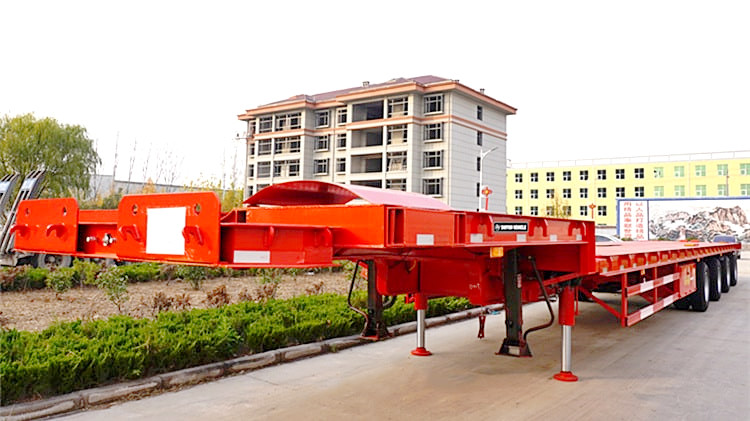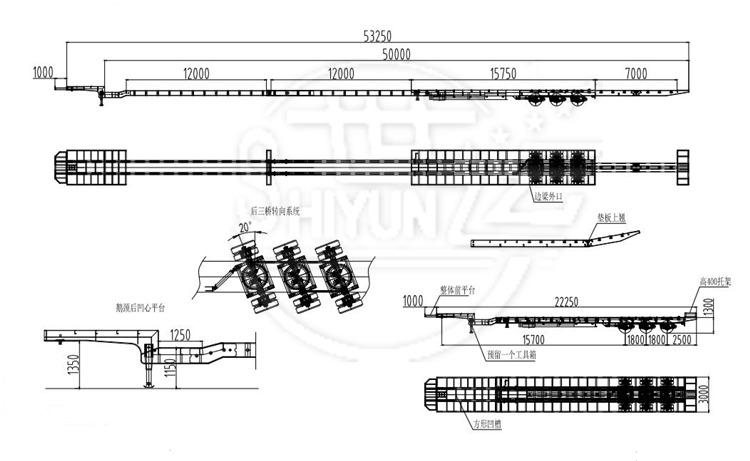1. What is Extendable Blade Trailer?
2. Design of the extendable beam.
3. Features of Extendable Trailers
4. Types of extendable blade trailers
An extendable blade trailer is a semi trailer with extendable loading area which has a loading length of up to 62 meters. The telescopic trailer is necessary for delivering goods such as rotor blades, wind turbines or iron girders to the site of operation.
The length of the loading area can be individually modified for each load by pushing the articulated truck apart or together using three telescopic extensions. The movable rear wheels of the heavy transport are especially important when cornering.
Extendable trailer and telescopic trailer for sale from China Shiyun are widely used for long cargo transport, especially for windmill parts logistics, such as wind blade, wind tower section, and turbine. The stretchable telescopic beam could be 2 or 3 parts. Total length can reach up to 62 meters.
The extendable trailer’s original design is using the mechanical axle, just like a low-bed trailer connect with a telescopic beam to make its length adjustable, so enable the trailer to adapt to different lengths of cargos.
The telescopic beam could be mounted in other semi trailers, giving you an extendable flatbed trailer, extendable drop deck trailer as well as extendable low bed trailer. The expandable trailer configuration is a trailer mechanism that is designed and adapted to be towed and used when the tractor is traveling along the road. The extensions on the trailer can effectively bear loads of different lengths that may be required. The mechanism of this type of trailer may include a front chassis and a rear chassis arranged in a telescopic connection, where each chassis may be supported by a separate wheel and axle assembly. They can be tilted side by side in the retracted state of the mechanism. The configuration can be spaced in an extended format of the mechanism.
The cooperation between the rear chassis and the front chassis allows the chassis to tilt with a largely rigid connection. When the trailer mechanism contracts, as the trailer mechanism extends, the chassis frame bypasses the horizontal axis to allow articulation. A device forming a locking mechanism is provided to fix the rear frame frame and the front frame frame in the assembly in the extended and contracted state of the transport mechanism.
The main components of the trailer are the powertrain, gooseneck, wheels, support device, frame electrical system, hydraulic suspension, brake system, ladder and hydraulic system.

3 Axle Extendable Blade Trailer

4 Axle Extendable Blade Trailer
 6 Axle Extendable Blade Trailer
6 Axle Extendable Blade Trailer

3 Axle Extendable Blade Trailer Drawing

4 Axle Extendable Blade Trailer Drawing

6 Axle Extendable Blade Trailer Drawing
Key components of an extendable trailer
The extendable trailer is a sturdy transport platform with gooseneck, frame, axle components, various hydraulic systems,
Braking system, steering system, power unit, electrical equipment, etc. The following is a detailed description of how these parts adapt to function:
Gooseneck function
The gooseneck function of the trailer is a hydraulic component, which can usually be adjusted by the telescopic expansion of the hydraulic cylinder.
The steering mechanism that pulls the retractable trailer is usually installed in the gooseneck.
The assembly and connection of the gooseneck are usually carried out through the turntable, wedges and tow pins and the tractor saddle.
As the tractor rotates, the steering cylinder is pushed and transmitted to the steering axle of the trailer through the hydraulic circuit.
Trailer frame
The expandable trailer frame structure has main beams, left and right half plates, and transverse devices.
This is the main structure of the trailer and bears the transported load. The half plates on the left and right are linked to the main beams by transverse devices.
These half plates can be pushed into the cylinder to adjust the width of the vehicle and form a wheelbase extension. The hydraulic gooseneck is installed at the head of the frame, and a hydraulic ladder is installed at the rear.
Hydraulic system
The trailer has a hydraulic system that includes control circuits such as suspension lifting, gooseneck lifting, synchronous steering, lateral adjustment and lifting ladders.
The basic components of a hydraulic system are hydraulic valve blocks, joints and pipes. The entire system is equipped with a hydraulic source through the power unit. A safety valve is also installed in the loop.
Braking system
To further enhance the rapid operation of the extendable trailer, a braking system is provided. This includes service brakes, two-line car braking systems and parking brakes.
The power line and control line are set separately. The most important components include the connector to the tractor,
Various specifications of emergency relay valve, gas storage tank, dual brake chambers and components connected with pipelines.
Electrical system
The 24V single wire system constitutes the electrical system of the retractable trailer. In general, the electrical system includes lights, connectors and wires, and other components.
The electrical connection of the selected tractor is the national standard 24N electrical connector.
The external signal and lighting components are usually equipped with brake lights, rear position lights and position lights, and positions useful in this application.
System Power
The power unit consists of a small diesel engine, which is the main driving force. Other components include hydraulic oil tanks, control lines and pipes, and hydraulic pumps. This unit provides hydraulic source for the hydraulic system of the trailer.
In conclusion
Due to the ever-changing requirements of cargo in terms of size, especially in length and width, the need to build durable solutions has led to the manufacture of scalable trailers. Rather than buying a full-power vehicle to carry different loads of different lengths, an expandable trailer towed by a tractor can help reduce the cost of buying many vehicles to adapt to different situations. With an extendable trailer, you can now adjust the platform to accommodate different lengths of cargo and use the tractor to transport them comfortably. The trailer can be expanded in the longitudinal or width direction to achieve two different or almost the same aspects of expansion (vertical) and expansion (horizontal). According to your needs and the type of goods to be transported, you can choose either of the two types to meet different lengths or widths of the goods.

Details of the 6 axle extendable trailer for blade
Extendable single-beam
This design of the extendable trailer is the newest, making the most extended length of the trailer. The trailer’s most significant feature is that the three extensions are in the front of the trailer.
The single-beam can reduce the telescopic beam’s weight to the most and lightweight the trailer in a good way.
Reinforced single-beam
Above telescopic beam has three or four extensions, can make the trailer’s total length extended up to 50 meters. The extendable beam’s size is up to 30-40 meters, with customized and different dimensions as options.
The gooseneck in the drawing is a conventional fixed neck. Modular trailer’s hydraulic gooseneck can be an option to connect with the extendable beam.
Extendable double-beams
The two axle-lines rear trailer is a hydraulic multi-axle trailer. The maximum turning angle is more than 45 degrees. The length of the rear extension is up to 8 meters.
For our initial design of the extendable trailer, we used a two-girder telescopic extension. This twin-beam is also a kind of reinforced type. But if the total length is more than 45 meters after we extend the trailer’s telescopic beam, the trailer’s weight is very hard to control. The option of folding extension in the rear of the extendable trailer. The folding extension can replace the extendable rear beam to reduce the thickness of the platform deck, furthermore to minimize the height of the trailer.

10 Axle Extendable Trailer for Wind Tower Transport
Key Features:
-Extendable 3 times or more for different transport requirements.
-Axles with steering turntable make it easy for turning.
-On the front part of the working platform can be designed lower to low the centre of gravity.
-Landing leg of the extendable flatbed trailer is JOST brand.
-Axles are strictly tested before using to keep the transporting safety.
Three options of axle: mechanical leaf spring suspension, hydraulic axle suspension, and airbag suspension.
The hydraulic steering system minimizes the turning radius, increases the flexibility of the whole trailer.
Hydraulic modular trailers are options to replace the rear axle module, to increase payload capacity and maneuverability.
All wheels steerable:
When no-load, the telescopic beam can drawback to shorten the total length of the extendable trailer.
Extendable telescopic beam/boom protects wind turbine rotor blade from any damages or distortions during logistic, it just performed like bracket holder of the rotor blade. Please go blade trailer if you need to know more info. Strong Version Telescopic Trailers. Sometimes we can use the extendable trailer to transport the windmill blades and transport other heavier and longer cargos.


Extendable Blade Trailer with all steerable wheels product test
Ordinary extendable blade trailer
Ordinary extendable blade transport vehicles are a bit similar to lowbed transport vehicles, but the girder adopts a buckle box design. The girder is pulled to adjust the length of the vehicle to adapt to the transportation of different lengths of blades. The trailer is generally up to 62 meters long.
Axial blade transport semi-trailer
The biggest difference between the axial blade transport semi trailer and the ordinary extendable blade trailer transporter is that the chassis adopts a hydraulic axis design, which makes the blade trailer's cargo deck lower and steering more flexible.
Lifting blade transport semi trailer
Lifting blade transport semi trailer refers to a blade transporter equipped with a hydraulic lifting device. It is mainly aimed at the transportation of vanes in mountainous areas. In the case of flat roads, the blades are transported flat. In the case of extremely small turning radius in mountainous areas, the height of the transported items can be raised through the lifting device (usually 5-10 meters), and the length of the entire vehicle can be shortened to bypass obstacles.
1) The extendable trailers are able to transport all side of windmill blades? Yes, in order to meet the requirement of blades with different lengths, we sill design according to the blade information that is provided by our customers.
2) How will you transport the extendable flatbed trailers to our port, please? For the extendable blade trailer, we can use the bulk cargo or ships for shipping. It depends on cost and safety.
3) Do you have the adapter rotor trailer, please? We need it for mountain road transport. Yes, we have it, please check on the related products.